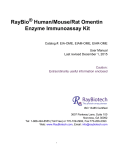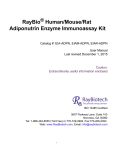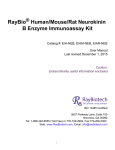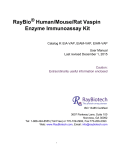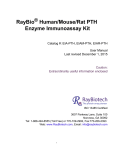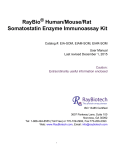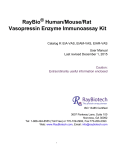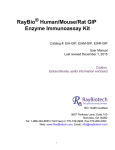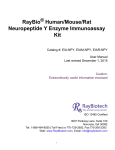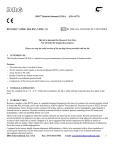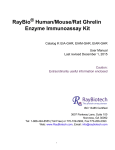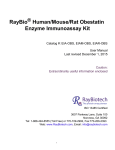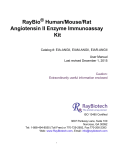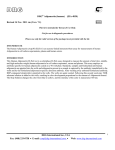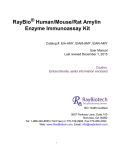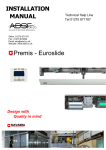Download Manual - RayBiotech, Inc.
Transcript
RayBio® Human/Mouse/Rat Resistin Enzyme Immunoassay Kit Catalog #: EIA-RES, EIAM-RES, EIAR-RES User Manual Last revised December 1, 2015 Caution: Extraordinarily useful information enclosed ISO 13485 Certified 3607 Parkway Lane, Suite 100 Norcross, GA 30092 Tel: 1-888-494-8555 (Toll Free) or 770-729-2992, Fax:770-206-2393 Web: www.RayBiotech.com, Email: [email protected] 1 Table of Contents Section Page # I. Introduction 3 II. General Description 4 III. How It Works 4 IV. Storage 5 V. Reagents 5 VI. Additional Materials Required 6 VII. Reagent Preparation A. Preparation of Plate and Anti-Resistin Antibody B. Preparation of Biotinylated Peptide (Item F) C. Preparation of Standards D. Preparation of Positive Control E. Preparation of Samples F. Preparation of Wash Buffer and HRP-Strep 6 6 7 8 9 9 10 VIII. Assay Procedure 10 IX. Assay Procedure Summary 11 X. Calculation of Results A. Typical Data B. Sensitivity C. Detection Range D. Reproducibility E. Assay Diagram 12 12 12 12 12 13 XI. Specificity 14 XII. Select Publications 14 XIII. Troubleshooting Guide 15 Please read the entire manual carefully before starting your experiment 2 I. Introduction Resistin is a 12.5 kDa cysteine-rich hormone secreted by adipose tissue. It is also known as XCP-1 (CEBPE regulated myeloid-specific secreted cysteine-rich protein precursor 1), FIZZ3 (found in inflammatory zone 3), or ADSF (adipocyte-specific secretory factor). The length of the resistin is 108 amino acids in humans, and 114 amino acids in mouse and rat; the molecular weight is ~12.5 kDa. Resistin is an adipokine with physiologic role regarding its involvement with obesity and type II diabetes mellitus (T2DM). Resistin has a high sequence homology among species (43% in a mature protein). Crystal structures of resistin reveal an unusual composition of several subunits that are held together by non-covalent interactions which make up its structure. Each protein subunit comprises a carboxy-terminal disulfide-rich Beta-sandwich "head" domain and an amino-terminal alpha-helical "tail" segment. The globular domain from resistin contains five disulfide bonds. Some studies have shown the important role of resistin linking obesity to T2DM. The underlying belief among those in support of this theory is that serum resistin levels will increase with increased adiposity. Conversely, serum resistin levels have been found to decline with decreased adiposity following medical treatment. This fact takes on significant implications considering the well understood link between central obesity and insulin resistance; marked peculiarities of T2DM. Furthermore, many studies have shown the positive correlations between resistin levels and insulin resistance, and a direct correlation between resistin levels and subjects with T2DM, indicating that such serum resistin increases are accountable for the insulin resistance apparently associated with increased adiposity. In addition to its role in insulin resistance in obese subjects, resistin also plays a role in inflammation and energy homeostasis. 3 II. General Description The RayBio® Resistin Enzyme Immunoassay (EIA) Kit is an in vitro quantitative assay for detecting Resistin peptide based on the competitive enzyme immunoassay principle. In this assay, a biotinylated Resistin peptide is spiked into the samples and standards. The samples and standards are then added to the plate, where the biotinylated Resistin peptide competes with endogenous (unlabeled) Resistin for binding to the anti-Resistin antibody. After a wash step, any bound biotinylated Resistin then interacts with horseradish peroxidase (HRP)-streptavidin, which catalyzes a color development reaction. The intensity of the colorimetric signal is directly proportional to the amount of captured biotinylated Resistin peptide and inversely proportional to the amount of endogenous Resistin in the standard or samples. A standard curve of known concentration of Resistin peptide can be established and the concentration of Resistin peptide in the samples can be calculated accordingly. III. How It Works 4 IV. Storage The entire kit may be stored at -20°C to -80°C for up to 6 months from the date of shipment. For extended storage, it is recommended to store at -80°C. Avoid repeated freeze-thaw cycles. For prepared reagent storage, see table below. V. Reagents Component Size / Description Storage / Stability After Preparation Resistin Microplate (Item A) 96 wells (12 strips x 8 wells) coated with secondary antibody. 1 month at 4°C* Wash Buffer Concentrate (20X) (Item B) 25 ml of 20X concentrated solution. 1 month at 4°C Standard Resistin Peptide (Item C) 2 vials of Resistin Peptide. 1 vial is enough to run each standard in duplicate. The first standard: 2-3 days at 4°C Additional dilutions: Do not store Anti-Resistin Polyclonal Antibody (Item N) 2 vials of anti-Resistin. 1 month at 4°C Assay Diluent A (Item D) 30 ml, contains 0.09% sodium azide as preservative. Diluent for standards and serum or plasma. N/A Assay Diluent B (Item E) 15 ml of 5X concentrated buffer. Diluent for standards, cell culture media or other sample types, and HRP-Streptavidin. 1 month at 4°C Biotinylated Resistin Peptide (Item F) 2 vials of Biotinylated Resistin Peptide, 1 vial is enough to assay the whole plate. 2-3 days at 4°C HRP-Streptavidin Concentrate (Item G) 600 µl 160X concentrated HRP-conjugated streptavidin. Do not store and reuse Positive Control (Item M) 1 vial of Positive Control. 2-3 days at 4°C TMB One-Step Substrate Reagent (Item H) 12 ml of 3,3,5,5'-tetramethylbenzidine (TMB) in buffer solution. N/A Stop Solution (Item I) 8 ml of 0.2 M sulfuric acid. N/A *Return unused wells to the pouch containing desiccant pack, reseal along entire edge. 5 VI. Additional Materials Required 1. 2. 3. 4. 5. 6. 7. 8. 9. 10. 11. Microplate reader capable of measuring absorbance at 450 nm Precision pipettes to deliver 2 µl to 1 ml volumes Adjustable 1-25 ml pipettes for reagent preparation 100 ml and 1 liter graduated cylinders Absorbent paper Distilled or deionized water SigmaPlot software (or other software which can perform four-parameter logistic regression models) Tubes to prepare standard or sample dilutions Orbital shaker Aluminum foil Plastic wrap VII. Reagent Preparation Keep kit reagents on ice during reagent preparation steps. Note: Assay Diluent A should be used for dilution of samples, Item F and Item C when testing plasma or serum samples. 1X Assay Diluent B should be used for dilution of samples, Item F and Item C when testing cell culture media or other sample types. A. Preparation of Plate and Anti-Resistin Antibody 1. Equilibrate plate to room temperature before opening the sealed pouch. 2. Label removable 8-well strips as appropriate for your experiment. 3. 5X Assay Diluent B (Item E) should be diluted 5-fold with deionized or distilled water. 4. Briefly centrifuge the anti-Resistin antibody vial (Item N) Then add 50 µl of 1X Assay Diluent B to the vial to prepare the antibody concentrate. Pipette up and down to mix gently. 5. The antibody concentrate should then be diluted 100-fold with 1X Assay Diluent B. This is your anti-Resistin antibody working solution, which will be used in step 2 of Assay Procedure (Section VIII). 6 Note: The following steps may be done during the antibody incubation procedure (step 2 of Assay Procedure) B. Preparation of Biotinylated Resistin (Item F) 5. Briefly centrifuge the vial of Biotinylated Resistin (Item F) before use. 6. See the image below for proper preparation of Item F. Transfer the entire contents of the Item F vial into a tube containing 10 ml of the appropriate Assay Diluent. This is your Working Stock of Item F. Pipette up and down to mix gently. The final concentration of biotinylated Resistin will be 20 ng/ml. a. Second Dilution of Item F for Standards: Add 2 ml of Working Stock Item F to 2 ml of the appropriate Assay Diluent. The final concentration of biotinylated Resistin will be 10 ng/ml. b. Second Dilution of Item F for Positive Control: Add 100 µl of Working Stock Item F to 100 µl of the prepared Positive Control (Item M). (See section D for Positive Control preparation) The final concentration of biotinylated Resistin will be 10 ng/ml. c. Second Dilution of Item F for samples: Add 125 µl of Working Stock Item F to 125 µl of prepared sample (see section E for sample preparation). This is a 2-fold dilution of your sample. The final concentration of biotinylated Resistin will be 10 ng/ml. 7 C. Preparation of Standards 7. Label 6 microtubes with the following concentrations: 1000 ng/ml, 100 ng/ml, 10ng/ml, 1 ng/ml, 100 pg/ml and 0 pg/ml. Pipette 450 µl of biotinylated Resistin Item F working solution (prepared in step 6a) into each tube, except the 1,000 ng/ml (leave this one empty). It is very important to make sure the concentration of biotinylated Resistin is 10 ng/ml in all standards. 8. Briefly centrifuge the vial of Resistin Standard (Item C). Pipette 8 µl of Item C and 792 µl of 10 ng/ml biotinylated Resistin working solution (prepared in step 6a) into the tube labeled 1000 ng/ml. Mix thoroughly. This solution serves as the first standard (1,000 ng/ml Resistin standard, 10 ng/ml biotinylated Resistin). 9. To make the 100 ng/ml standard, pipette 50 µl of the 1000 ng/ml Resistin standard into the tube labeled 100 ng/ml. Mix thoroughly. 10. Repeat this step with each successive concentration, preparing a dilution series as shown in the illustration below. Each time, use 450 µl of biotinylated Resistin and 50 µl of the prior concentration until the 100 pg/ml is reached. Mix each tube thoroughly before the next transfer. 8 D. Positive Control Preparation 11. Briefly centrifuge the Positive Control vial (Item M). 12. Refer to step 6b. This is a 2-fold dilution of the Positive Control. The final concentration of biotinylated Resistin should still be 10 ng/ml. The Positive Control is a cell culture media sample that serves as a system control to verify that the kit components are working. The resulting OD will not be used in any calculations; if no positive competition is observed please contact RayBiotech Technical Support. The Positive Control may be diluted further if desired, but be sure the final concentration of biotinylated Resistin is 10 ng/ml. E. Sample Preparation 13. If you wish to perform a 2-fold dilution of your sample, proceed to step 6c. If you wish to perform a higher dilution of your sample, dilute your sample with the appropriate Assay Diluent before performing step 6c. EXAMPLE (to make a 4-fold dilution of sample): a. Dilute sample 2-fold (62.5 µl of sample + 62.5 µl of the appropriate Assay Diluent.). b. Perform step 6c (125 µl of working solution Item F + 125 µl of sample prepared above). The total volume is 250 µl, enough for duplicate wells on the microplate. It is very important to make sure the final concentration of the biotinylated Resistin is 10 ng/ml. Note: Optimal sample dilution factors should be determined empirically, however you may reference below for recommended dilution factors for serum: Human=2X Mouse=2X Rat=2X. If you have any questions regarding the recommendended dilutions you may contact technical support at 888-494-8555 or [email protected]. 9 F. Preparation of Wash Buffer and HRP 14. If Item B (20X Wash Concentrate) contains visible crystals, warm to room temperature and mix gently until dissolved. 15. Dilute 20 ml of Wash Buffer Concentrate into deionized or distilled water to yield 400 ml of 1X Wash Buffer. 16. Briefly centrifuge the HRP-Streptavidin vial (Item G) before use. 17. Dilute the HRP-Streptavidin concentrate 160-fold with 1X Assay Diluent B. Note: do not use Assay Diluent A for HRP-Streptavidin preparation in step 17 VIII. Assay Procedure 1. Keep kit reagents on ice during reagent preparation steps. It is recommended that all standards and samples be run at least in duplicate. 2. Add 100 µl of Anti-Resistin Antibody (Item N) (See Reagent Preparation step 3) to each well. Incubate for 1.5 hours at room temperature with gentle shaking (1-2 cycle/sec). You may also incubate overnight at 4ºC. 3. Discard the solution and wash wells 4 times with 1X Wash Solution Buffer (200300 µl each). Washing may be done with a multichannel pipette or an automated plate washer. Complete removal of liquid at each step is essential to good assay performance. After the last wash, remove any remaining Wash Buffer by aspirating or decanting. Invert the plate and blot it against clean paper towels. 4. Add 100 µl of each standard (see Reagent Preparation Section C), Positive Control (see Reagent Preparation Section D) and sample (see Reagent Preparation Section E) in appropriate wells. Be sure to include a blank well (Assay Diluent only). Cover wells and incubate for 2.5 hours at room temperature with gentle shaking (1-2 cycles/sec) overnight or at 4ºC. 5. Discard the solution and wash 4 times as directed in Step 3. 6. Add 100 µl of prepared HRP-Streptavidin solution (see Reagent Preparation step 7) to each well. Incubate for 45 minutes at room temperature with gentle 10 shaking. It is recommended that incubation time should not be shorter or longer than 45 minutes. 7. Discard the solution and wash 4 times as directed in Step 3. 8. Add 100 µl of TMB One-Step Substrate Reagent (Item H) to each well. Incubate for 30 minutes at room temperature in the dark with gentle shaking (1-2 cycles/sec). 9. Add 50 µl of Stop Solution (Item I) to each well. Read at 450 nm immediately. IX. Assay Procedure Summary 1. Prepare all reagents, samples and standards as instructed. 2. Add 100 µl anti-Resistin to each well. Incubate 1.5 hours at room temperature or overnight at 4ºC. 3. Add 100 µl standard or sample to each well. Incubate 2.5 hours at room temperature or overnight at 4ºC. 4. Add 100 µl prepared Streptavidin solution. Incubate 45 minutes at room temperature. 5. Add 100 µl TMB One-Step Substrate Reagent to each well. Incubate 30 minutes at room temperature. 6. Add 50 µl Stop Solution to each well. Read at 450 nm immediately. 11 X. Calculation of Results Calculate the mean absorbance for each set of duplicate stands, controls, and samples and subtract the blank optical density. Plot the standard curve using SigmaPlot software (or other software which can perform four-parameter logistic regression models), with standard concentration on the x-axis and percentage of absorbance (see calculation below) on the y-axis. Draw the best-fit curve through the standard points. Percentage absorbance = (B-blank OD)/B 0-blank OD) where B = OD of sample or standard and B0 = OD of zero standard (total binding) A. Typical Data These standard curves are for demonstration only. A standard curve must be run with each assay. B. Sensitivity The minimum detectable concentrations of Resistin is 446 pg/ml. C. Detection Range 0.1-1,000 ng/ml D. Reproducibility Intra-Assay: CV<10% Inter-Assay: CV<15% 12 E. Assay Diagram Recommended Plate Layout: Key: Blank = Buffer Only Total Binding = Biotin- Resistin only Standard 1 = 1000 ng/ml Standard 2 = 100 ng/ml Standard 3 = 10 ng/ml Standard 4 = 1 ng/ml Standard 5 = 100 pg/ml Pos Control = Biotin with Item M 13 XI. Specificity This kit detects Resistin (90aa). No other active isoforms have been reported. Cross Reactivity: This EIA kit shows no cross-reactivity with any of the cytokines tested: Ghrelin, Nesfatin, Angiotensin II, NPY and APC. XIV. Select EIA Publications 1. Plum L, Lin HV, Dutia R, Tanaka J, Aizawa KS, et al. The Obesity Susceptibility Gene Carboxypeptidase E Links FoxO1 Signaling in Hypothalamic Proopiomelanocortin Neurons with Regulation of Food Intake. Nature Med. 2009;15(10):1195-1201. (Ghrelin EIA, EIA-GHR-1) 2. Hug C, Lodish HF. Visfatin: a new adipokine. Science. 2005; 307(5708):366-7. 3. Kim MK. Crystal structure of visfatin/pre-B cell colony-enhancing factor 1/nicotinamide phosphoribosyltransferase, free and in complex with the anticancer agent FK-866. J Mol Biol. 2006; 362(1):66-77. 4. Revollo, J.R., et al. The NAD biosynthesis pathway mediated by nicotinamide phosphoribosyltransferase regulates Sir2 activity in mammalian cells. J. Biol. Chem. 2004; 279: 50754-50763. 5. Oh-I S, Shimizu H, Satoh T, et al. Identification of nesfatin-1 as a satiety molecule in the hypothalamus. Nature 2006; 443 (7112): 709-12. 6. Zhang J, Ren P, Avsian-Kretchmer O, Luo C, Rauch R, Klein C, Hsueh A. Obestatin, a peptide encoded by the ghrelin gene, opposes ghrelin's effects on food intake. Science 2005; 310 (5750): 996-9. 7. Cummings D, Weigle D, Frayo R, Breen P, Ma M, Dellinger E, Purnell J. Plasma ghrelin levels after diet-induced weight loss or gastric bypass surgery. N Engl J Med 2002; 346 (21): 1623-30. 8. Tschop M, Smiley DL, Heiman ML. Ghrelin induces adiposity in rodents. Nature 2002; 407 (6806): 908-913.9. Kojima M, Hosoda H, Date Y, Nakazato M, Matsuo H, Kangawa K. Ghrelin is a growth-hormone-releasing acylated peptide from stomach. Nature 1999; 402 (6762): 656-60. 14 XIII. Troubleshooting Guide Problem Cause Solution Inaccurate pipetting Improper standard dilution Check pipettes Briefly centrifuge Item C and dissolve the powder thoroughly by gently mixing Low signal Improper preparation of standard and/or biotinylated antibody Too brief incubation times Inadequate reagent volumes or improper dilution Briefly spin down vials before opening. Dissolve the powder thoroughly. Ensure sufficient incubation time; assay procedure step 2 may be done overnight Check pipettes and ensure correct preparation Large CV Inaccurate pipetting Air bubbles in wells Check pipettes Remove bubbles in wells High background Plate is insufficiently washed Contaminated wash buffer Review the manual for proper wash. If using a plate washer, ensure that all ports are unobstructed. Make fresh wash buffer Improper storage of the ELISA kit Stop solution Follow storage recomendations in sections IV and V. Keep substrate solution protected from light. Add stop solution to each well before reading plate Poor standard curve Low sensitivity 15 RayBio® ELISA Kits Over 2,000 ELISA kits available, visit www.RayBiotech.com/ELISA-Kits.html for details. This product is for research use only. ©2015 RayBiotech, Inc 16
















